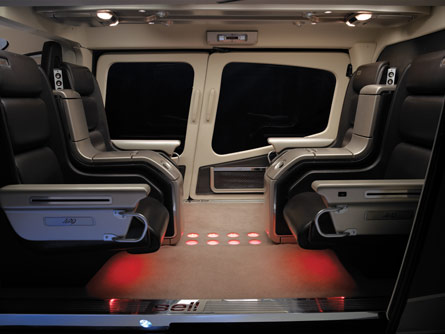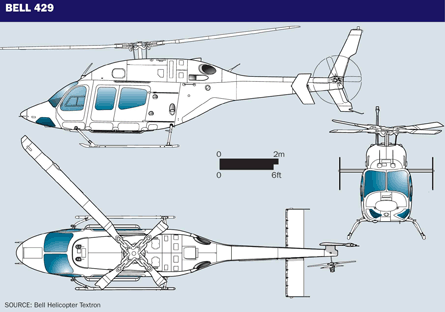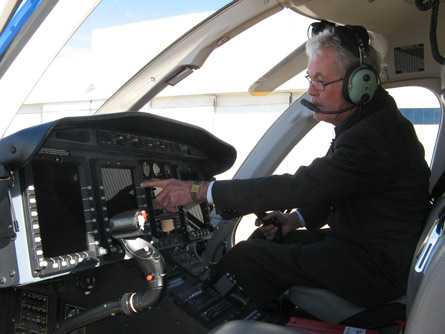With today's helicopter accident rate well above that of fixed-wing aircraft, particularly in emergency medical services and utility communities, there is great cause for concern in the industry. Among the preventatives that have been established to reduce the rate are proactive as well as reactive safety management systems and proper maintenance quality control.
But a more fundamental factor in correcting the trend is perhaps providing safe aircraft that have safe procedures, safe systems and safe equipment - ingredients Bell Helicopter has brought to market in spades with its new 429 twin.
I travelled to Bell's training headquarters at Alliance airport in Fort Worth, Texas, in January to fly and evaluate the 429 with respect to these safety features. The single-pilot instrument flight rules helicopter received Canadian, European and US certification in 2009.
FLIGHT CONDITIONS
My pilot for the flight was Erik Eriksen, senior production test pilot, and Bell engineer Paul Mayrand. The day was cold, at -6°C (21°F), but clear. There was a gusty 15kt (28km/h) wind, a good input for a test flight to see how the helicopter responds and reacts.
 |
|---|
© Bell HelicopterBell opted for a clean-sheet design for its new 429 and chose to produce a fully single-pilot IFR machine from the outset |
Eriksen took me round a standard pilot pre-flight inspection. It was simple and easy, even inspecting the main rotor head. As we went round, I noted:
- The wide passenger steps.
- No jettisonable doors (but this aircraft is not aimed primarily at the offshore market).
- No push-out windows (an optional extra), but Mayrand says that you can, in an emergency, bash your way out of the cabin. The windows are large, giving the occupants excellent visibility.
- The large, lit baggage compartment, with a 2.1m3 (74ft3) with 16 tie-down points. It will take many golf bags, says Eriksen. However, surprisingly, there is no smoke detector. There are no circuit breakers overhead in the cockpit, just a few by the feet. The majority are all in the baggage bay. This makes a pleasant change from most other cluttered cockpits.
- A single fuel filler spout. This in addition supplies the optional extra auxiliary tank that can be fitted on the cabin floor and connected within minutes.
- The all-composite tail boom with the flat underside to accept customer antennas. The composites are much more damage tolerant. Damage can be repaired rather than having to change the whole boom, says Bell. Composites give good protection against the elements such as corrosion.
- The newly designed tail rotor. This is the first time Bell has gone for four blades. This tail rotor consists of two conventional two-bladed systems on a single shaft. It runs slower than most others. So this makes it quieter, but still powerful. The fin has a cut-out area that allows more tail rotor authority at low speeds. I was to check this during the flight.
- The many access panels.
The external fuselage is mostly made up of composite materials. These offer less drag (no rivets and the like), lighter weight and resistance to harsh environments. Bell has designed a new set of main rotor carbonfibre blades using new manufacturing technologies enabling the shape to be optimised, thus giving enhanced performance and lower noise. No lubrication is required at the rotor head.
The 429's hot, high and heavy performance is particularly impressive, especially with the latest Pratt & Whitney Canada PW207D1 engines. These deliver 598shp (446kW), 5min take-off power each and an impressive 729shp 30s single-engine power. This should be enough power to rescue a pilot from the most difficult situation in the event of a sudden engine failure.
ENGINE POWER
The engines can produce much more power (719shp take-off power, 826shp 30s power). However, power is controlled by the fully automatic electronic control systems. But it is comforting for the crew to know that they still have lots of power available at high altitude in a difficult situation.
The power situation indicator shows the limiting factor to power availability or which limit is approaching its maximum. The one engine inoperative (OEI) training mode and real OEI operation in case of an actual engine failure has an override function.
The 429 is certificated as European Aviation Safety Agency JAR Ops class one performance at maximum take-off weight. This means that it can suffer an engine failure at any time and the pilot has a choice of landing back on to the take-off area, which could be just a helipad with no runway or, say, a rooftop, or continue the flight. This can be from a high hover.
The same protection is available at the landing area. Of course, the pilots need to be trained in how to manage an engine failure at such critical times. So Bell gives excellent training at its Forth Worth academy. A simulator will be available about mid-year. The simulator can be fitted with an operator's take-off and landing sites.
The tail rotor drive shaft is also revolutionary. It is made of composites and there are only two lengths and two bearings. There are no anti-ice systems, but the aircraft can enter icing conditions safely provided it leaves the area as soon as practical.
Maintenance has been made simple with 200h and 400h inspections are visual only. The 800h (annual inspection) is a combination of visual and other techniques. Bell reckons that the maintenance time to flight time will be about 1:1.
I climbed up easily into the right-hand seat using the steps and grabs - more attention to detail. I adjusted the seat, pedals and the luxury of a lumbar support to attain a comfortable position within reach of everything. This is important since this helicopter is a single-pilot IFR machine.
OVERHEAD COMPONENTS
I looked around and liked what I saw. The only overhead components are the rotor brake, air vent, light and hook for the headset. There are no circuit breakers, switches, knobs or engine speed select levers. The two throttles, in true Bell tradition, are on the end of the collective pitch lever, just right for single-pilot IFR operations.
The windscreen is huge with excellent visibility with narrow door/window struts on my right. Bell has fitted its own avionics package to the machine.
The system calculates weight, balance, centre of gravity, inside and outside ground effect parameters, Category A profiles and other subjects. Flight data for the last 70 flight hours is recorded and downloadable. This includes the helicopter utilisation monitoring system, which alerts the technicians of an impending or probable problem with the dynamic components, and helicopter operation monitoring system, which detects any deviations from the proper flightpath or other events such as hot starts, speed and altitude busts.
 |
|---|
© Bell HelicopterLarge windows give good visibility |
A responsible operator will take the crew aside and discuss the causes with confidentiality. Actions to prevent recurrence are taken and the tape erased.
Both systems are extremely useful proactive safety devices. Other safety features include an undercarriage designed to take a lot of stress, with any excess taken up by the fuselage and crash-attenuating seats. All the seats have upper body restraint with four-point harnesses. The design also attempts to prevent the main gearbox from penetrating the cabin, a real killer in earlier aircraft, and offers rollover protection.
Some available safety features exceed the regulatory requirements, including a crash attenuating fuel system, flight data recorder, cockpit voice recorder, terrain awareness warning system and traffic collision awareness system.
The instrument panel is dominated by two 6 x 8in (15 x 20cm) LCDs that display the aircraft's position in space and where it is going. There is a choice of how much information the pilot requires or how little.
I found the flight instruments displayed as round, conventional dials more convenient than the vertical strips that most other modern helicopters have. I was able with a single glance to take in the information presented by the large attitude indicator, the airspeed indicator on the left, the altimeter on the right and the large compass below to visualise the basic parameters of the flight.
LCD SCREENS
The other dominant factor in the panel is the third same-size LCD that can show engine, torque and rotor parameters, fuel management and whatever else the pilot chooses. The fourth smaller screen shows navigation information, GPS, communications and has the three-axis digital autopilot control switches. There is also a dual channel stability control augmentation system (SCAS).
Above this screen are the three "get you home" steam driven (as we say in the trade) instruments - an attitude and airspeed indicator and a compass. These are available if all the other computer-driven instruments fail - something that has happened to me in the Eurocopter Tiger.
Overhead is a moveable glarescreen and at both ends of the instrument panel cowling an adjustable holder with light for instrument flying plates - yet another nice attentive touch to detail. I have had difficulty in other aircraft holding the instrument plate in one hand and flying the helicopter with the other in instrument conditions.
The cyclic stick can be locked to keep the main rotor disc level. There is plenty of room for stowage of documents or whatever else the crew require. There is also space on the centre console for the operator to install additional equipment.
 |
|---|
Although students will be required to use the checklist, test pilot Eriksen used a flow pattern starting from the back of the centre console and sweeping across the instrument panel. As soon as the power is on, the systems self-test. We had an external power cart, but the aircraft can be started using internal battery power.
Both engines can be started in quick succession, even straight to flying rotor RPM NR. The whole operation takes about 2-3min, says Eriksen, including the self-test. Such a quick start is necessary for search and rescue and EMS operations where time is paramount. I selected the start switch and sat back to watch. Both engine starts were slow and cool.
FIRST HOVER
I taxied out and lined up on the runway and came to my first hover. Eriksen gave me only the SCAS. As expected, because the controls are sensitive in this condition, there was some slight pilot induced oscillation (PIO). With experience, this disappeared even to the point where I could land downwind from the hover in the 15kt gusty wind. Power available in the hover was easily interpreted. We had lots available. In the cruise, a modest 75% torque gave 135kt; 93% gave us 150kt.
Maximum continuous torque is 100% so there is plenty of power in hand even at much higher altitudes. A slight dive took us to the VNE of 155kt. Vibration levels at this speed were benign, even during the helicopter's 30° banked turns.
When I removed my headset, noise level was also benign, just a slight buzz from the engines. The aircraft is very agile - Eriksen performed sustained 90° banked turns in both directions at high speed. Visibility into the right-hand turn around the thin door/window strut on my right was adequate.
Vibration levels were also low. I invited Eriksen to close one throttle quickly at high forward speed and do nothing. NR drooped momentarily from 100% to 98%, but was restored to 100% within seconds. We had a good alert from the warnings system. The power instruments reverted to single-engine configuration.
Although Eriksen had not explored vortex ring state/settling with power, he had such confidence that he was willing to try. So down we went, downwind at about 300ft/min (1.52m/s) and hardly any airspeed. All the warning signs were there - continuous yawing from left to right, increased rate of descent. I could feel the aircraft accelerating down. Recovery by moving the cyclic stick forward for positive airspeed, then applying enough power to climb, gave instant recovery from the condition.
RATE OF DESCENT
A pilot would have to be very naive not to recognise the signs. Eriksen was invited to move the collective pitch lever rapidly up and down over a large power range. The FADECs controlled the NR to within 1%. There were no attitude changes, particularly in pitch. A 100kt maximum range autorotation gave a rate of descent of 2,100ft/min; the minimum rate of descent at 53kt/1,800ft/min.
Flare effect at ground level gave a significant temporary increase of NR, killed all our forward speed and gave plenty of time to level into the hover. At this point power was restored quickly by the FADECs. I felt that a real engines-off landing would be benign - a job for the simulator, maybe.
Eriksen programmed the flight management system to take us to Bell's satellite airfield. The route, speed and altitude were selected and we sat back to watch the aircraft quickly capture these parameters. The 429 can carry out a hands-off instrument approach right down to an automatic levelling at 50ft above the runway.
Eriksen switched off one hydraulic system while I was flying the aircraft. The warning system gave us the necessary information. There was no difference in handling. Even the tail rotor has dual systems, unlike some Bell and other helicopters. Surprisingly the aircraft cannot be flown with no hydraulic power, unlike, say, the much heavier 212.
We next explored a FADEC failure. The warnings were adequate. The pilot uses the manual throttle to control the engine. Keeping it just below the good engine is standard procedure on most helicopters. It was easy to fly the approach, hover and landing using this procedure.
SINGLE-ENGINED LANDING
We went into the circuit to perform a single-engine landing. To protect the engines against using real single-engine power with possible excursions into 30s and 2min power, there is an engine-out training mode. The pilot has all the sensations and indications of being on one engine, but in reality, the remaining engine power is limited to maximum continuous and the "failed" engine sits at flight idle, ready to perform should it be required.
There was plenty of power in hand, although we were light in the cold air, but I am confident that even hot, high and heavy conditions, the pilot has enough power to arrive safely. We were able to hover and land. I carried out a very steep approach to the helipad. I had to cock the nose slightly left to keep the target in view in the lower window. This is normal with most helicopters. I arrived accurately over the H.
Handling out of wind hovering to 90°, 180° and 270° was benign, even with the stabilisation taken out. PIO had gone by now. I took the aircraft up to a high outside ground effect hover and was able to achieve an accurate hover. After I tried my hand at fairly fast sideways, backwards and turns on the spot manoeuvres, I handed over to Eriksen who demonstrated really fierce manoeuvring, but, following him through on the controls, at no time did he run out of tail rotor power, thanks to the slightly offset and four-blades arrangement, or into excessive power.
Finally we went on to the slopes. The steepest we could find was 8°. There was still plenty of cyclic stick available, normally, the first limiting parameter.
My overriding impressions are the attention to detail, the passenger and crew user friendliness, even though the 429 is a complex aircraft, and the comfort of all the occupants. The management of flight concept has changed from having to pole the aircraft to programming it where you want to go, at what height and speed and then sit back and monitor. Just like a modern fixed-wing aircraft.
So Bell trains not only how to manually fly the aircraft but also to programme and how to monitor the results. As well as initial conversion courses to both pilots and technicians, its academy offers refresher training.
 |
|---|
©Bell HelicopterPeter Gray found the 429 panel to his liking and was happy with noise levels after removing his headset |
The 429 appears to have met all of Bell's design criteria. The machine is fast, quiet, smooth, has plenty of power, is passenger and pilot user friendly and comfortable and has a good range and endurance.
Maintenance hours are low and the maintenance system has been simplified. It is efficient. While a Bell 212 cruises at about 105kt using a fuel flow of 272kg/h (600lb/h) at 2,000ft, the 429 slips along at 147kt. at the same fuel flow. And this at much lower noise and vibration levels.
At 4,000ft standard atmosphere, pulling maximum continuous power of 100% will take you to the VNE and a useful 165kt true airspeed. Not many helicopters can achieve VNE in level flight.
As a result of Bell's testing programmes, direct operating maintenance costs have already reduced from the initial estimate of $1,800 per hour with 87 components having conservative times between overhaul (TBO) to now only 17 such components.
TBOs are aimed at 5,000h. This lowers the operating costs to about $463 using an annual flight time of 800h. With more testing, this might reduce to $400, says Neil Marshall, the 429 programme director. The maintenance manual is of a new technology design, keeping it simple. It has exploded views providing significantly more detail than ever.

Once Bell and the operators have gained experience, there is the potential to make a bigger derivative aircraft using the same technology. Bell has already flight-tested the 429 at 3,629kg, 454kg above its approved weight in support of such studies.
This, like all development programmes, will require a market need and a successful business case to be developed.
Source: Flight International
















